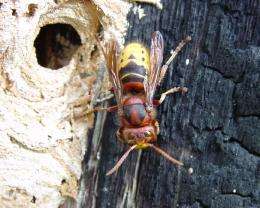July 31, 2012 report
Researchers find wasps are the key to yeast's ability to survive through winter

(Phys.org) -- For over nine thousand years people have been relying on various yeast strains to carry out fermentation of food and drink products resulting in the flavorful breads and alcohol fueled beverages we consume, but until now, no one really knew how it was that the yeast managed to appear on schedule every year to help us out, especially in places where freezing winter temperatures would seem to make that impossible. Now, thanks to new research by a combined team of French and Italian researchers, the answer seems to have been found, and as they write in their paper published in the Proceedings of the National Academy of Sciences, it appears that we have the wasp to thank.
For years scientists have assumed that yeast’s ability to show up on virtually every grape that appears in a vineyard was most likely due either to birds or bees. The yeast lack a means of moving themselves about and depending on wind to carry them seemed too random. But until now, no one had figured out just who or what was responsible or was able to explain how they survived through long cold winters. Some had investigated birds, but they found that the fungus didn’t survive in them long, which led naturally to insects. But which ones? The team narrowed down the possible choices quickly by focusing only on those that are able to not only survive through the winter, but to produce new young in the spring. That led to wasps, which hibernate then build nests in the spring leading to new young offspring.
To find out if wasps were indeed the savior of yeasts, the team collected samples from seventeen different areas in and around vineyards in Italy. Lo and behold they found that the majority of them harbored yeast in their guts, and what’s more did so throughout all four seasons, including just prior to hibernation and just after. They also found that the yeast turned up in the guts of the young shortly after they were first fed ensuring that the yeast could carry on indefinitely.
The researchers also found that the wasps harbored all manner of yeasts, noting over 230 strains in just those they studied, some of which matched those used to make some of our foods and drinks and some that live in the wild. Thus it seems that wasps are at least one of the major players in the life cycle of yeasts. The research team isn’t suggesting that wasps are solely responsible for allowing yeasts to move between grapes and other berries or for helping them make it through the winter, but at least now, one source is known for sure.
More information: Role of social wasps in Saccharomyces cerevisiae ecology and evolution, PNAS, Published online before print July 30, 2012, doi: 10.1073/pnas.1208362109
Abstract
Saccharomyces cerevisiae is one of the most important model organisms and has been a valuable asset to human civilization. However, despite its extensive use in the last 9,000 y, the existence of a seasonal cycle outside human-made environments has not yet been described. We demonstrate the role of social wasps as vector and natural reservoir of S. cerevisiae during all seasons. We provide experimental evidence that queens of social wasps overwintering as adults (Vespa crabro and Polistes spp.) can harbor yeast cells from autumn to spring and transmit them to their progeny. This result is mirrored by field surveys of the genetic variability of natural strains of yeast. Microsatellites and sequences of a selected set of loci able to recapitulate the yeast strain’s evolutionary history were used to compare 17 environmental wasp isolates with a collection of strains from grapes from the same region and more than 230 strains representing worldwide yeast variation. The wasp isolates fall into subclusters representing the overall ecological and industrial yeast diversity of their geographic origin. Our findings indicate that wasps are a key environmental niche for the evolution of natural S. cerevisiae populations, the dispersion of yeast cells in the environment, and the maintenance of their diversity. The close relatedness of several wasp isolates with grape and wine isolates reflects the crucial role of human activities on yeast population structure, through clonal expansion and selection of specific strains during the biotransformation of fermented foods, followed by dispersal mediated by insects and other animals.
Journal information: Proceedings of the National Academy of Sciences
© 2012 Phys.org
















